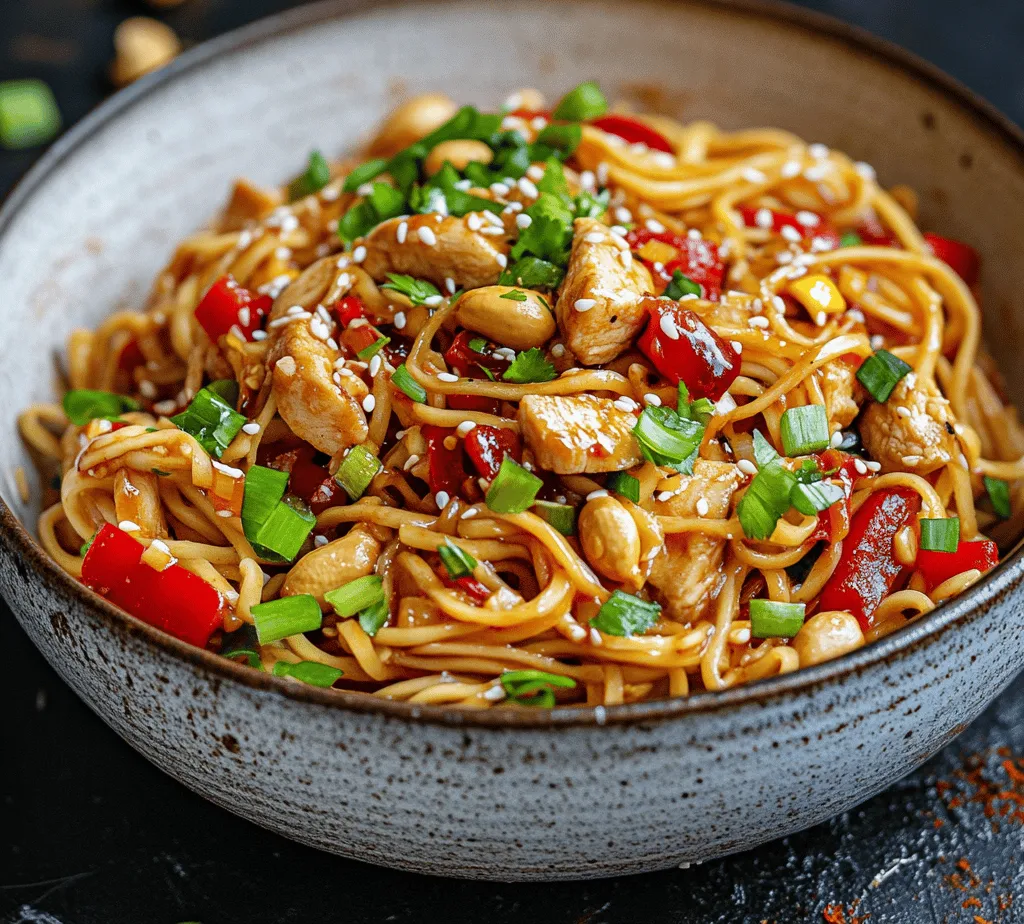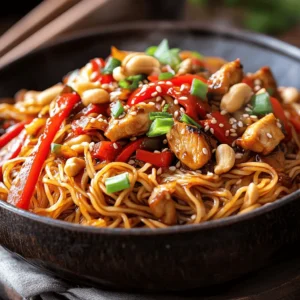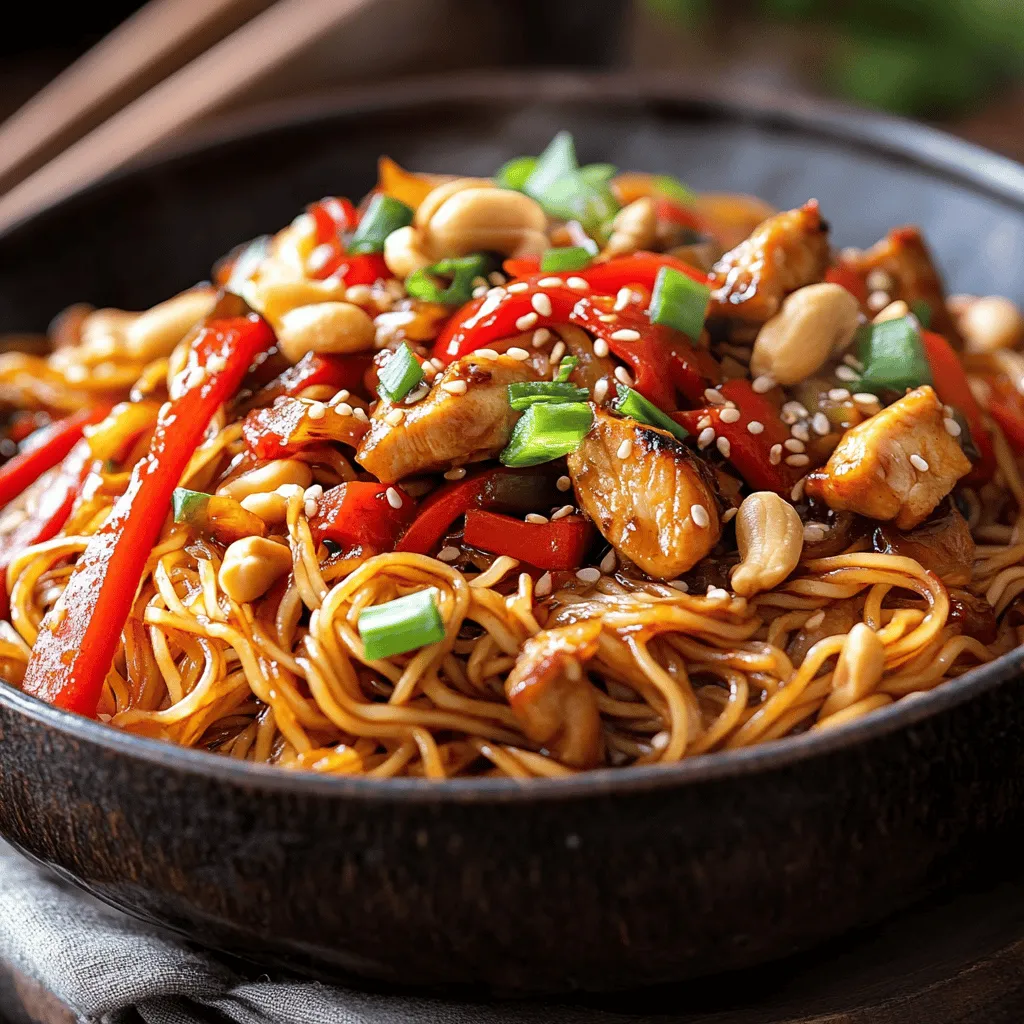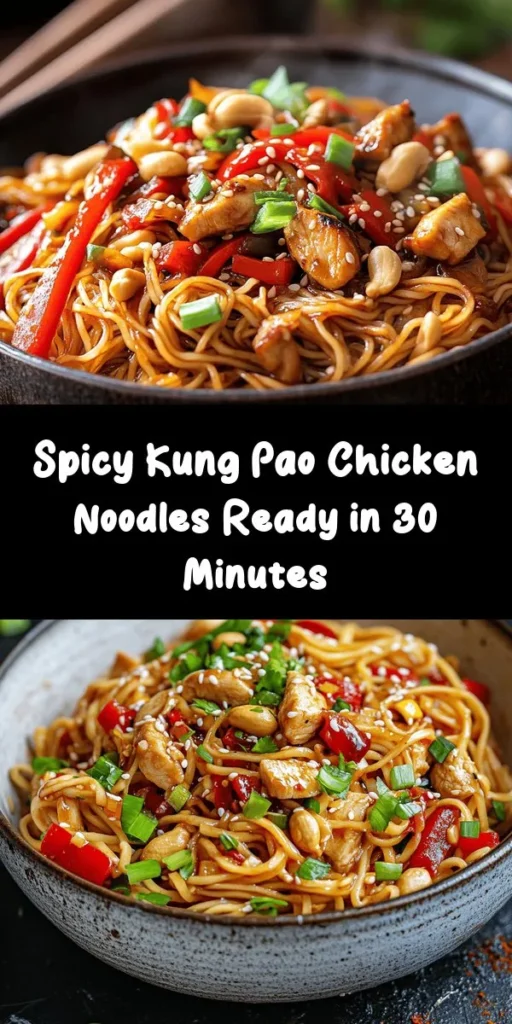Introduction
Kung Pao Chicken Noodles are a delightful fusion dish that marries the traditional flavors of Kung Pao Chicken with the comforting texture of noodles. This dish has gained immense popularity not only in Chinese cuisine but also in Western adaptations, appealing to those who crave a hearty yet flavorful meal. With its unique flavor profile characterized by spicy, sweet, and savory notes, Kung Pao Chicken Noodles offer a satisfying experience that delights the palate.
At the heart of this dish lies a perfect balance of protein, vegetables, and carbohydrates. Tender chicken breast, vibrant vegetables, and chewy egg noodles come together in a luscious sauce that elevates the entire dish. This recipe is not only delicious but also straightforward, making it an excellent choice for both novice cooks and seasoned chefs looking for a quick weeknight dinner.
The Allure of Kung Pao Chicken Noodles
Kung Pao Chicken has its roots in Sichuan cuisine, where it is revered for its bold flavors and aromatic spices. Traditionally, this dish features diced chicken stir-fried with peanuts and vegetables, all coated in a spicy sauce made from soy sauce, vinegar, and chili peppers. The evolution of this classic dish into Kung Pao Chicken Noodles reflects the adaptability of Chinese cuisine, allowing it to evolve and cater to various tastes around the world.
What makes Kung Pao Chicken Noodles stand out is the harmonious blend of flavors. The heat from the chili peppers is perfectly balanced by the sweetness of hoisin sauce and the tanginess of rice vinegar. The addition of crunchy peanuts adds another layer of texture, making each bite a delightful experience. This dish is not just a feast for the taste buds; it also offers visual appeal with its vibrant colors from the vegetables and the glossy sheen of the sauce coating the noodles.
The popularity of Kung Pao Chicken Noodles can be attributed to its versatility. It can be easily tailored to suit personal preferences, whether by adjusting the level of spice, incorporating different vegetables, or even substituting proteins. This adaptability, combined with its rich cultural significance, has made it a beloved dish on menus worldwide.
Ingredients Breakdown
Creating the perfect Kung Pao Chicken Noodles requires a selection of fresh ingredients that work in unison to create a delicious and satisfying dish. Below is a detailed list of the ingredients along with their roles in this recipe:
Chicken Breast
The star protein of this dish is chicken breast, which provides a lean and tender base. When prepared correctly, chicken breast remains juicy and flavorful. For this recipe, it’s essential to cut the chicken into bite-sized pieces to ensure even cooking and easy incorporation into the noodles. Marinating the chicken briefly in soy sauce and cornstarch not only enhances its flavor but also helps in achieving a velvety texture.
Egg Noodles
Egg noodles are the ideal choice for this Kung Pao Chicken Noodles recipe due to their rich flavor and chewy texture. These noodles pair perfectly with the sauce, allowing them to soak up the flavors without becoming mushy. When cooked properly, egg noodles provide a delightful contrast to the tender chicken and crunchy vegetables, enhancing the overall mouthfeel of the dish.
Vegetables
Fresh vegetables play a crucial role in adding both flavor and nutrition to Kung Pao Chicken Noodles. Key vegetables include:
– Bell Pepper: Adds a sweet crunch and vibrant color to the dish.
– Garlic: Infuses a fragrant aroma and depth of flavor.
– Ginger: Offers a spicy warmth that complements the other ingredients.
Incorporating these vegetables not only enhances the dish’s taste but also boosts its nutritional value, making it a well-rounded meal.
Peanuts
Peanuts are a signature ingredient in Kung Pao Chicken, contributing a delightful crunch and richness to the dish. They also serve as a source of healthy fats and protein. When toasted, peanuts release their natural oils, enhancing their flavor and adding a nutty aroma to the overall dish.
Sauces
The sauce is where the magic happens in Kung Pao Chicken Noodles. A combination of several key sauces creates a complex flavor profile:
– Soy Sauce: Provides saltiness and umami, forming the base of the sauce.
– Rice Vinegar: Adds a tangy brightness that cuts through the richness of the dish.
– Hoisin Sauce: Offers sweetness and depth, balancing the heat from the chili.
– Chili Paste: Infuses the dish with heat, allowing for customization based on personal taste.
Cornstarch
Cornstarch plays a vital role in thickening the sauce and giving it a glossy sheen. It helps bind the flavors together, ensuring that every bite is bursting with taste. When combined with the marinaded chicken, cornstarch also contributes to achieving that desirable velvety texture.
Preparation Steps
To create mouthwatering Kung Pao Chicken Noodles, it’s essential to follow a series of steps that build flavor and ensure proper cooking techniques. Below is a detailed description of each step, emphasizing the importance of timing and method.
Cooking the Noodles
The first step in preparing Kung Pao Chicken Noodles is to cook the egg noodles. Start by bringing a large pot of salted water to a boil. It’s important to season the water, as this will enhance the noodles’ flavor during cooking. Once the water is boiling, add the egg noodles and cook according to the package instructions until they are al dente, typically around 4-5 minutes.
Timing is crucial here—overcooking the noodles can lead to a mushy texture that won’t hold up well in the dish. After draining the noodles, rinse them briefly under cold water to stop the cooking process and prevent them from sticking together. Drizzle a little sesame oil over the noodles, tossing them gently to coat. This not only adds flavor but also helps keep the noodles separate as you continue with the recipe.
Preparing the Chicken
While the noodles are cooking, it’s time to prepare the chicken. Start by cutting the chicken breast into bite-sized pieces, ensuring they are uniform for even cooking. In a bowl, combine the chicken with soy sauce and a teaspoon of cornstarch. This marinade will not only infuse the chicken with flavor but also create a protective coating during cooking, keeping the meat tender and juicy.
Let the chicken marinate for about 15-20 minutes, allowing the flavors to penetrate the meat. During this time, you can also chop the vegetables and prepare the sauce mixture, streamlining your cooking process.
Stir-Frying the Chicken
Once the chicken has marinated, heat a large wok or skillet over medium-high heat. Add a tablespoon of vegetable oil and allow it to heat until shimmering. Gently add the marinated chicken to the hot oil, spreading it out in a single layer. Avoid overcrowding the pan; if necessary, cook the chicken in batches to achieve a nice sear.
Stir-fry the chicken for about 4-5 minutes, or until it is golden brown and cooked through. Use a spatula to break up any clumps, ensuring even cooking. Once the chicken is cooked, remove it from the pan and set it aside.
Sautéing the Vegetables
In the same wok or skillet, add another splash of oil if needed, then toss in the chopped bell pepper, garlic, and ginger. Stir-fry the vegetables for about 2-3 minutes until they are vibrant and just tender. The key is to keep them crisp to maintain their texture in the final dish.
Once the vegetables are cooked, return the chicken to the pan, combining everything evenly. This step allows the flavors to meld together before adding the sauce.
Creating the Sauce
In a separate bowl, whisk together the soy sauce, rice vinegar, hoisin sauce, chili paste, and a tablespoon of cornstarch. This will be your sauce mixture that adds depth and flavor to the dish. Pour the sauce over the chicken and vegetables in the skillet, stirring to coat everything evenly.
As the sauce heats, it will begin to thicken, creating a glossy coating that clings to the chicken and vegetables. Allow the sauce to simmer for a minute or two, ensuring that all the ingredients are well combined and heated through.
Adding the Noodles and Peanuts
Finally, it’s time to bring everything together. Add the cooked egg noodles to the skillet, gently tossing them with the chicken and vegetables until they are fully incorporated. The noodles should be coated in the flavorful sauce, absorbing the aromatic elements of the dish.
Sprinkle the toasted peanuts over the top and give everything a final toss to combine. The peanuts add a delightful crunch, enhancing the overall texture of the dish.
By following these detailed preparation steps, you will create a delicious plate of Kung Pao Chicken Noodles that showcases the rich flavors and vibrant ingredients that make this dish a favorite among many. Stay tuned for the remaining steps and tips to perfect your culinary creation.

Marinating the Chicken
Marinating the chicken is an essential step in preparing Kung Pao Chicken Noodles, as it enhances the flavor and tenderness of the meat. A well-balanced marinade typically includes soy sauce, rice vinegar, cornstarch, and sesame oil. The soy sauce infuses the chicken with a savory depth, while rice vinegar adds a hint of acidity that brightens the overall flavor profile. Cornstarch serves a dual purpose: it not only helps to tenderize the chicken but also creates a slight coating that will later contribute to the sauce’s thickness.
Allow the chicken to marinate for at least 30 minutes, though longer (up to two hours) can yield even better results. This process allows the flavors to penetrate the meat, ensuring that every bite is juicy and flavorful. Moreover, marinating also serves to create a slight barrier that helps the chicken retain moisture during cooking, which is particularly important when stir-frying at high temperatures.
Stir-frying Techniques
Stir-frying is a hallmark of Chinese cooking and is crucial for achieving the perfect texture in Kung Pao Chicken Noodles. The significance of high heat and quick cooking cannot be overstated; these techniques help to lock in flavors and maintain the integrity of the ingredients. When stir-frying, the ideal temperature should be high enough to create a slight sear on the chicken, which adds a delightful complexity to the dish.
Using a wok is highly recommended due to its shape and ability to distribute heat evenly. If a wok isn’t available, a large skillet will suffice. It’s essential to keep the chicken and vegetables moving in the pan; this ensures that they cook evenly and prevents burning. Cooking in batches may be necessary if your pan is not large enough to accommodate all the ingredients at once. Overcrowding the pan can lead to steaming rather than stir-frying, which will compromise the desired texture.
Vegetable Sautéing
The order in which you sauté your vegetables plays a critical role in maximizing flavor release and ensuring even cooking. Start with ingredients that take longer to soften, such as bell peppers and onions, before adding quicker-cooking vegetables like zucchini or snap peas. This method not only ensures that everything is cooked to perfection but also allows the flavors to meld beautifully.
Begin by heating a small amount of oil in your wok or skillet. Once hot, add the harder vegetables first, stirring them frequently until they begin to soften. After a few minutes, add the quicker-cooking vegetables, stirring to combine. This technique helps to retain the crispness of the vegetables while still allowing them to absorb the delicious sauce later in the process.
Combining Ingredients
Once the chicken is stir-fried to a golden brown and the vegetables are vibrant and tender-crisp, it’s time to combine all the elements. Begin by adding the marinated chicken back to the pan, followed by the Kung Pao sauce—a mixture of soy sauce, hoisin sauce, rice vinegar, and a touch of sugar.
To ensure an even coating, pour the sauce over the chicken and vegetables while continuously stirring. This method allows the sauce to envelop the ingredients, infusing them with flavor and ensuring that every bite is as delicious as the next. Be mindful not to overcook at this stage; just a couple of minutes should suffice to heat through the sauce and meld the flavors together.
Thicken the Sauce
To achieve the desired consistency of your Kung Pao sauce, you may need to thicken it slightly toward the end of the cooking process. If your sauce seems too thin, you can create a slurry using cornstarch and water. Combine one tablespoon of cornstarch with two tablespoons of cold water in a small bowl, whisking until smooth. Gradually pour this mixture into the sauce while continuously stirring, allowing it to cook for an additional minute until it thickens to your liking. The result should be a glossy, rich sauce that clings to the chicken and noodles beautifully.
Serving Suggestions
Presentation plays an important role in the enjoyment of any dish, and Kung Pao Chicken Noodles are no exception. Once the dish is plated, consider garnishing it with freshly chopped scallions and a sprinkle of toasted sesame seeds for added texture and flavor. A few crushed peanuts on top will also enhance the traditional Kung Pao experience, adding crunch and a nutty flavor that complements the dish beautifully.
For an appealing serving suggestion, consider placing the noodles in a shallow bowl or a wide plate, then layering the stir-fried chicken and vegetables on top. Drizzling a little extra sauce over the dish just before serving can elevate the visual appeal and ensure that every bite is flavorful.
Nutritional Information
Kung Pao Chicken Noodles not only tantalize the taste buds but also offer a range of nutritional benefits. A typical serving contains approximately 400-500 calories, depending on the portion size and specific ingredients used.
Nutritional Breakdown (per serving):
– Calories: 450
– Protein: 30g
– Fats: 18g (mostly from sesame oil and peanuts)
– Carbohydrates: 45g (derived from noodles and vegetables)
This dish fits seamlessly into a balanced diet due to its inclusion of lean protein from the chicken, fiber-rich vegetables, and complex carbohydrates from the noodles. The variety of colors and textures in the dish also indicates a good range of vitamins and minerals.
Variations and Substitutions
One of the great things about Kung Pao Chicken Noodles is their versatility. For those following a vegetarian or vegan diet, consider substituting the chicken with tofu or tempeh, both of which can absorb the marinade and sauce flavors beautifully. For a gluten-free version, utilize gluten-free soy sauce and rice noodles instead of traditional wheat-based noodles.
You can also customize the dish by adding a variety of vegetables such as bok choy, broccoli, or carrots for additional nutrients and flavor. If you’re looking to diversify your protein options, shrimp or beef can also work well in this recipe, each bringing a unique flavor profile to the dish.
Additionally, exploring regional variations of Kung Pao can introduce exciting twists. For instance, some versions incorporate Szechuan peppercorns for a unique numbing heat, while others may include dried chilies for a smoky flavor. Each variation reflects the local culinary traditions and can inspire creativity in your own kitchen.
Culinary Techniques and Tips
Key cooking techniques used in this recipe, such as stir-frying and marinating, are foundational to achieving authentic flavors and textures. Stir-frying allows for high heat cooking, which is perfect for quickly searing proteins and vegetables while preserving their freshness.
Mise en place, or preparing all ingredients before you begin cooking, is crucial for an efficient cooking experience. Having everything prepped and ready to go minimizes stress and ensures that you can focus on achieving the perfect stir-fry without interruptions.
When it comes to spice levels, Kung Pao Chicken can range from mild to fiery, depending on personal preference. If you enjoy heat, consider adding more dried chilies or a splash of chili sauce. Conversely, for a milder version, reduce the amount of spice in the sauce or omit the chilies altogether.
Conclusion
Kung Pao Chicken Noodles are not only a delightful dish to prepare but also a vibrant representation of the rich flavors and culinary techniques found in Chinese cuisine. With their ease of preparation and the ability to customize ingredients, this recipe is perfect for both experienced cooks and those just starting their culinary journey.
Encouraging readers to try making Kung Pao Chicken Noodles at home offers them an opportunity to enjoy a fulfilling meal that brings the essence of traditional Chinese cooking into their kitchens. This dish reflects the cultural significance of the Kung Pao style, which has evolved over centuries into a beloved staple that combines flavor, texture, and visual appeal.
Ultimately, home-cooked meals like Kung Pao Chicken Noodles not only provide nourishment but also foster a sense of joy and comfort, reminding us of the importance of sharing good food with loved ones. With its vibrant colors, bold flavors, and satisfying ingredients, Kung Pao Chicken Noodles are sure to become a favorite in any household.



